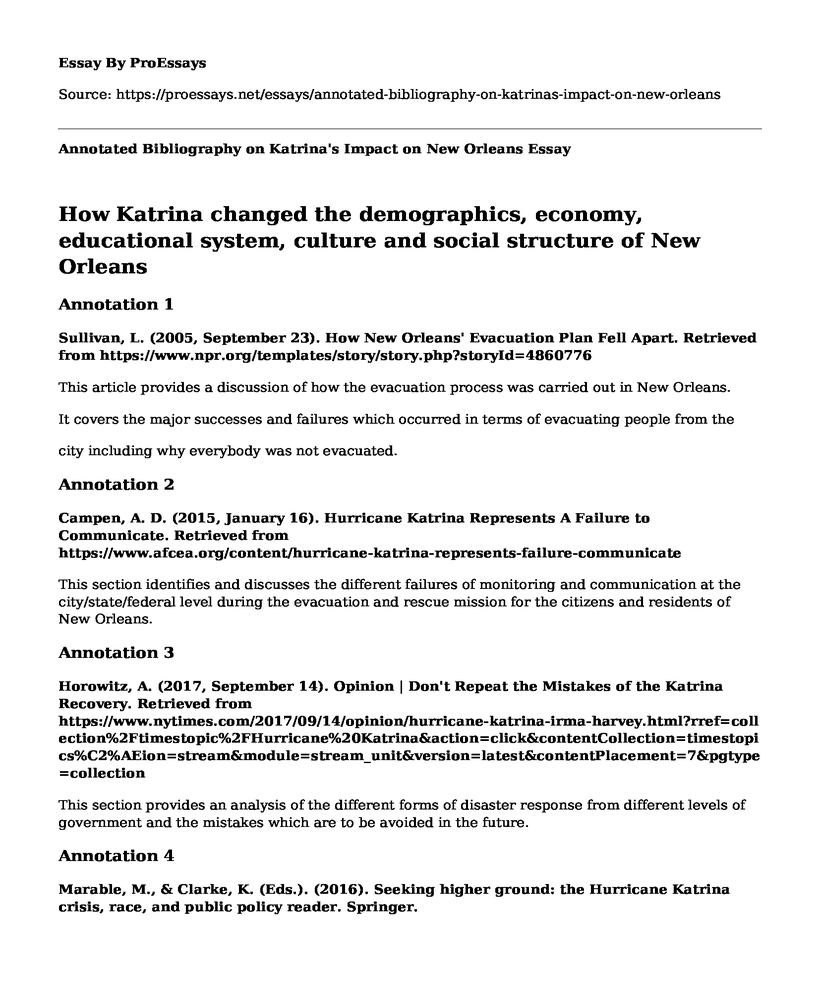How Katrina changed the demographics, economy, educational system, culture and social structure of New Orleans
Annotation 1
Sullivan, L. (2005, September 23). How New Orleans' Evacuation Plan Fell Apart. Retrieved from https://www.npr.org/templates/story/story.php?storyId=4860776
This article provides a discussion of how the evacuation process was carried out in New Orleans.
It covers the major successes and failures which occurred in terms of evacuating people from the
city including why everybody was not evacuated.
Annotation 2
Campen, A. D. (2015, January 16). Hurricane Katrina Represents A Failure to Communicate. Retrieved from https://www.afcea.org/content/hurricane-katrina-represents-failure-communicate
This section identifies and discusses the different failures of monitoring and communication at the city/state/federal level during the evacuation and rescue mission for the citizens and residents of New Orleans.
Annotation 3
Horowitz, A. (2017, September 14). Opinion | Don't Repeat the Mistakes of the Katrina Recovery. Retrieved from https://www.nytimes.com/2017/09/14/opinion/hurricane-katrina-irma-harvey.html?rref=collection%2Ftimestopic%2FHurricane%20Katrina&action=click&contentCollection=timestopics%C2%AEion=stream&module=stream_unit&version=latest&contentPlacement=7&pgtype=collection
This section provides an analysis of the different forms of disaster response from different levels of government and the mistakes which are to be avoided in the future.
Annotation 4
Marable, M., & Clarke, K. (Eds.). (2016). Seeking higher ground: the Hurricane Katrina crisis, race, and public policy reader. Springer.
This section provides a discussion on the impacts of the storm among the different racial or economic groups in the city. It shows which populations were affected the most and why.
Annotation 5
The New York Times. (2013, October 28). Hurricane Katrina Aftermath: In the Shadow | Retro Report | The New York Times [Video file]. Retrieved from https://www.youtube.com/watch?v=hlLh9WoZxfk
The video provides infographics evaluation of the immediate aftermath of Katrina in the city. It provides evidence of property damage.
Annotation 6
Santos, N. (2019, April 26). Fourteen Years Later, New Orleans is Still Trying to Recover from Hurricane Katrina. Retrieved from https://www.eesi.org/articles/view/fourteen-years-later-new-orleans-is-still-trying-to-recover-from-hurricane-katrina
The article identifies how New Orleans is yet to recover fully many years after the disaster. It evaluates the rate in which different racial groups returned to the city.
Annotation 7
Fussell, E., Sastry, N., & VanLandingham, M. (2010). Race, socioeconomic status, and return migration to New Orleans after Hurricane Katrina. Population and Environment, 31(1-3), 20-42.
This section argues How Katrina changed the demographics, economy, educational system, culture and social structure of New Orleans.
Cite this page
Annotated Bibliography on Katrina's Impact on New Orleans. (2023, Feb 20). Retrieved from https://proessays.net/essays/annotated-bibliography-on-katrinas-impact-on-new-orleans
If you are the original author of this essay and no longer wish to have it published on the ProEssays website, please click below to request its removal:
- Yarnell Hill Fire Essay Example
- Essay Example on American Art: Exploring Gender, Native American & Colonist Identity
- Essay Example on Making Foreigners: Exploring American Citizenship & Alienage
- Essay Example on Chinese Opera: Its Origin & Impact Since 1280
- Early US Slavery - Free Essay Example
- Reasons Behind Movement in the US - Essay Example
- Migration in Europe - Research Paper Sample







